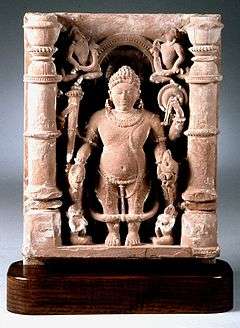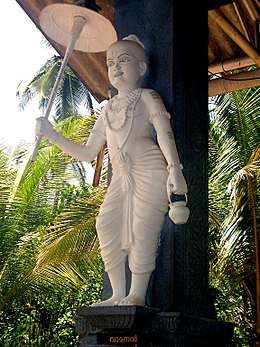Vamana
| Vamana | |
|---|---|
 The dwarf avatar of Vishnu, Vamana | |
| Affiliation | Vaishnavism |

Vamana (Sanskrit: वामन, IAST: Vāmana, lit. dwarf), is the fifth avatar of Hindu god Vishnu.[1][2] He incarnates in a time of crisis to restore cosmic balance by creatively defeating the Asura king Mahabali, who had acquired disproportionate power over the universe. According to Hindu mythology, the noble demon king sponsors a sacrifice and gift giving ceremony to consolidate his power, and Vishnu appears at this ceremony as a dwarf mendicant Brahmin called Vamana.[1] When Vamana's turn comes to receive a gift, Mahabali offers him whatever riches and material wealth he would like, but Vamana refuses everything and states he would just like three paces of land. Mahabali finds the dwarf's request amusingly small and irrevocably grants it.[1] Vamana then grows into a giant of cosmic proportions. In one step he covers the earth, in another the heavens, and for the third, Mahabali offers his head on which Vamana steps, sending the demon king to the Patala (netherworld).[1][3]
The Vamana avatar has roots in Vedic texts of Hinduism. The hymns of the Rigveda describes Vishnu as that benevolent god who in three steps defined all there is in the universe.[1][4] The giant form of Vamana is also known as Trivikrama (literally, "three steps").[5] The Vamana legend has been a popular one, inspiring icons found in Hindu temples and sections in Hindu texts such as the Puranas and the epics. About thirty different versions of his mythology are found in these texts.[6]
Etymology
The Sanskrit word Vamana (वामन) means "dwarf".[3] He is also known as Trivikrama (त्रिविक्रम) means the three steps, representing the Svarga (heaven), the earth, and the Patala (netherworld).
The legend of Vishnu covering the universe in three steps is found in Vedic texts. For example, hymns, 1.22 and 1.154 of the Rigveda describe Vishnu as that bountiful, kind, just god in three steps defined all there is in the universe.[1][4] Other Rigvedic hymns that mention three steps of Vishnu include 1.154, 6.49, 7.100 and 8.29, and in these the context is of a benevolent god who protects the oppressed humanity by his creative acts against the evil.[4]
Origin
Aditi took Payovrata to propitiate Lord Vishnu. As a result, Vamana was born to Aditi and Kashyapa.[7] He is the twelfth of the Adityas.
Hinduism

The Bhagavata Purana describes that Vishnu descended as the Vamana avatar to restore the authority of Indra over the heavens, as it had been taken by a benevolent Asura King Mahabali (or simply called Bali). Bali was the great grandson of Hiranyakshipu, the grand son of Prahlada and son of Virochana. Vamana, as a dwarf Brahmin carrying a wooden umbrella, went to the king to request for land that he could set his foot upon for three paces. Mahabali consented, against the warning of his guru, Shukracharya ,thinking of the limitations of the space of his foot. Vamana then enlarged to gigantic proportions to stride over the three worlds. He stepped from heaven to earth with the first step, from earth to the netherworld with the second. King Mahabali, unable to fulfill his promise, offered his head for the third. Vamana then placed his foot and gave the king immortality for his humility.[8] He was also allowed to return every year to see the citizens of his country. The festival of Onam for some and first day of Diwali for some is related to this return of Mahabali to a visit to earth once every year in August-September. Some texts state that Vamana gave the lordship of the netherworld to Bali. In giant form, Vamana is known as Trivikrama.[9]
According to another but similar version, Prahlada's grandson Mahabali came to power by defeating the gods (Devas), and taking over the three worlds. According to Vaishnavism mythology, the defeated Devas approached Vishnu for help in their battle with Mahabali.[10] Vishnu refused to join the gods in violence against Mahabali, because Mahabali was a good ruler and his own devotee. He, instead, decided to test Mahabali's devotion at an opportune moment. Mahabali, after his victory over the gods, declared that he will perform Yajna (homa sacrifices) and grant anyone any request during the Yajna. Vishnu took the avatar of a dwarf boy called Vamana and approached Mahabali. The king offered anything to the boy – gold, cows, elephants, villages, food, whatever he wished. The boy said that one must not seek more than one needs, and all he needs is the property right over a piece of land that measures "three paces". Mahabali agreed.[11][12] The Vamana grew and covered everything Mahabali ruled over in just two paces. For the third pace, Mahabali offered himself to the Vamana.[11]
Symbolism
| Part of a series on |
| Vaishnavism |
|---|
 |
|
Important deities |
|
Sampradayas |
|
|
Mahabali symbolizes Samridhi (prosperity), the three feet symbolizes the three states of existence (Jagrat (awake), Swapna (dream sleep) and Sushupti (deep sleep) and final step is on his head which elevates from these three states, unto moksha (spiritual liberation, release from rebirths).[9]
Onam festival
In one version of the Vamana legend, when Mahabali offered himself for Vishnu's third step, it was an act of Mahabali's devotion.[11] Vishnu granted him a boon. Mahabali chose to revisit earth, once every year, the lands and people he previously ruled. This revisit marks the festival of Onam, as reminder of the virtuous rule and his humility in keeping his promise before Vishnu.[11][13]
According to Nanditha Krishna, a simpler form of this legend, one without Mahabali, is found in the Rigveda and the Vedic text Shatapatha Brahmana where a solar deity is described with powers of Vishnu. This story likely grew over time, and is in part allegorical, where Bali is a metaphor for thanksgiving offering after a bounty of rice harvest during monsoon, and Vishnu is the metaphor of the Kerala sun and summer that precedes the Onam.[14] According to Roshen Dalal, the story of Mahabali is important to Onam in Kerala, but similar Mahabali legends are significant in the region of Balia in Uttar Pradesh, Bawan also in the same state, Bharuch in Gujarat, and Mahabaleshwar in Maharashtra. The story is significant not because Mahabali's rule ended, but it emphasizes the Hindu belief in cyclical nature of events, that no individual, no ruler and nothing lasts forever, except the virtues and self understanding that overcomes all sorrow.[15]
Iconography
Vamana iconography varies by region. Three icons are common, one shows his left foot raised above his knee, the second shows his foot above his navel, and the third shows it raised above the forehead. These icons respectively symbolize the three worlds – netherworld, earth and heaven – Vamana covered as Trivikrama.[16]
Temples
The Vamana iconography and images are found in many Vaishnava temples. Some Vamana temples include:
- Vamana temple at Marhia, Jabalpur (dated to 5th-century, Gupta Empire era)[17][18]
- Vamana temple in Nagpur complex of Ramagiri temples, Maharashtra (5th-century CE)[19]
- Vamana along with other avatars of Vishnu, at the Dashavatara Temple, Deogarh, Jhansi (Uttar Pradesh, dated 500-500 CE)[20]
- Thrikkakara Temple, Thrikkakkara, Cochin, Kerala
- Ulagalantha Perumal Temple, Kanchipuram in Kanchipuram
- Vamana Temple, Eastern Group of Temples, Khajuraho, Madhya Pradesh
- Ulagalantha Perumal Temple, Tirukoyilur in Tirukoilur, Viluppuram district, Tamil Nadu
- Kazheesirama Vinnagaram in Sirkazhi, Tamil Nadu
- [(Ulagaalanda Perumal}] in [(Thiruneermalai Divya Desam Near Pallavaram, Chennai}]
- [(Thri Vikrama Temple}] in [(Thamalam, Bank of Karamana River,Thiruvanathapuram}]
 Vamana taking a giant step, Nepal
Vamana taking a giant step, Nepal Vamana at the Badami cave temples, Karnataka
Vamana at the Badami cave temples, Karnataka- Vamana striding the heavens, Karnataka

 Vishnu as Trivikrama, Mamallapuram, Tamil Nadu
Vishnu as Trivikrama, Mamallapuram, Tamil Nadu The dwarf Vamana, Andhra Pradesh
The dwarf Vamana, Andhra Pradesh Vamana at Ellora caves, Maharashtra
Vamana at Ellora caves, Maharashtra
See also
![]()
References
- 1 2 3 4 5 6 James G. Lochtefeld (2002). The Illustrated Encyclopedia of Hinduism: N-Z. The Rosen Publishing Group. pp. 737, 84. ISBN 978-0-8239-3180-4.
- ↑ Deborah A. Soifer (1991). The Myths of Narasimha and Vamana: Two Avatars in Cosmological Perspective. State University of New York Press. p. 3–4. ISBN 978-0-7914-0800-1.
- 1 2 Constance Jones; James D. Ryan (2006). Encyclopedia of Hinduism. Infobase Publishing. p. 477. ISBN 978-0-8160-7564-5.
- 1 2 3 Deborah A. Soifer (1991). The Myths of Narasimha and Vamana: Two Avatars in Cosmological Perspective. State University of New York Press. pp. 18–19, 22–25. ISBN 978-0-7914-0800-1.
- ↑ James G. Lochtefeld (2002). The Illustrated Encyclopedia of Hinduism: N-Z. The Rosen Publishing Group. p. 711. ISBN 978-0-8239-3180-4.
- ↑ Deborah A. Soifer (1991). The Myths of Narasimha and Vamana: Two Avatars in Cosmological Perspective. State University of New York Press. pp. xiii, 113–116, 123–138. ISBN 978-0-7914-0800-1.
- ↑ Account of the several Manus and Manwantaras Vishnu Purana, translated by Horace Hayman Wilson, 1840, Book III: Chapter I. 265:22, at the request of the deities Vishńu was born as a midget, Vámana, the son of Adití by Kaśyapa. By applying to Mahabali for alms Kaśyapa was promised by the prince whatever he might demand, notwithstanding Śukra (the preceptor of the Daityas). The dwarf demanded as much space as he could step over at three steps and upon the assent of Mahabali he enlarged himself to such dimensions as to stride over the three worlds. Being worshipped however by Mahabali and his ancestor Prahláda, he conceded to them the sovereignty of Pátála.
- ↑ Gopal, Madan (1990). K.S. Gautam, ed. India through the ages. Publication Division, Ministry of Information and Broadcasting, Government of India. p. 74.
- 1 2 Chandra, Suresh (2012). Encyclopaedia of Hindu Gods and Goddesses. Kindle Edition.
- ↑ J. Gordon Melton (2011). Religious Celebrations: An Encyclopedia of Holidays, Festivals, Solemn Observances, and Spiritual Commemorations. ABC-CLIO. pp. 400–402. ISBN 978-1-59884-206-7.
- 1 2 3 4 J. Gordon Melton (2011). Religious Celebrations: An Encyclopedia of Holidays, Festivals, Solemn Observances, and Spiritual Commemorations. ABC-CLIO. p. 659. ISBN 978-1-59884-206-7.
- ↑ Nanditha Kirshna (2009). Book of Vishnu. Penguin Books. pp. 58–59. ISBN 978-81-8475-865-8.
- ↑ Gopal, Madan (1990). K.S. Gautam, ed. India through the ages. Publication Division, Ministry of Information and Broadcasting, Government of India. p. 74.
- ↑ Nanditha Krishna (2009). Book of Vishnu. Penguin Books. pp. 58–61. ISBN 978-81-8475-865-8.
- ↑ Roshen Dalal (2010). Hinduism: An Alphabetical Guide. Penguin Books. pp. 229–230. ISBN 978-0-14-341421-6.
- ↑ T. A. Gopinatha Rao (1993). Elements of Hindu iconography. Motilal Banarsidass. pp. 163–167. ISBN 978-81-208-0878-2.
- ↑ Chandra, Pramod (1970). "A Vamana Temple at Marhia and Some Reflections on Gupta Architecture". Artibus Asiae. 32 (2/3): 125–145. doi:10.2307/3249549.
- ↑ Meister, Michael W. (1996). "Man and Man-Lion: The Philadelphia Narasimha". Artibus Asiae. 56 (3/4): 291–301. doi:10.2307/3250120.
- ↑ Bakker, Hans (2013). "The Trivikrama Temple: A New Interpretation of Rāmagiri Evidence (3)". South Asian Studies. Taylor & Francis. 29 (2): 169–176. doi:10.1080/02666030.2013.833757.
- ↑ Alexander Lubotsky (1996), The Iconography of the Viṣṇu Temple at Deogarh and the Viṣṇudharmottarapurāṇa, Ars Orientalis, Vol. 26, The Smithsonian Institution and Department of the History of Art, pp. 65-80